This article is to introduce the difference between globe valves and gate valves.
What is Globe Valve?
A globe valve is similar to a ball valve, but the body is spherical in that it consists of a movable plug element and a stationary ring seat. It’s a common valve type that is used in industrial applications.
Design(Globe Valve Drawing)
Globe Valve 2”~16” Carbon Steel Class 150LB

Globe Valve 2”~16” Carbon Steel Class 300LB
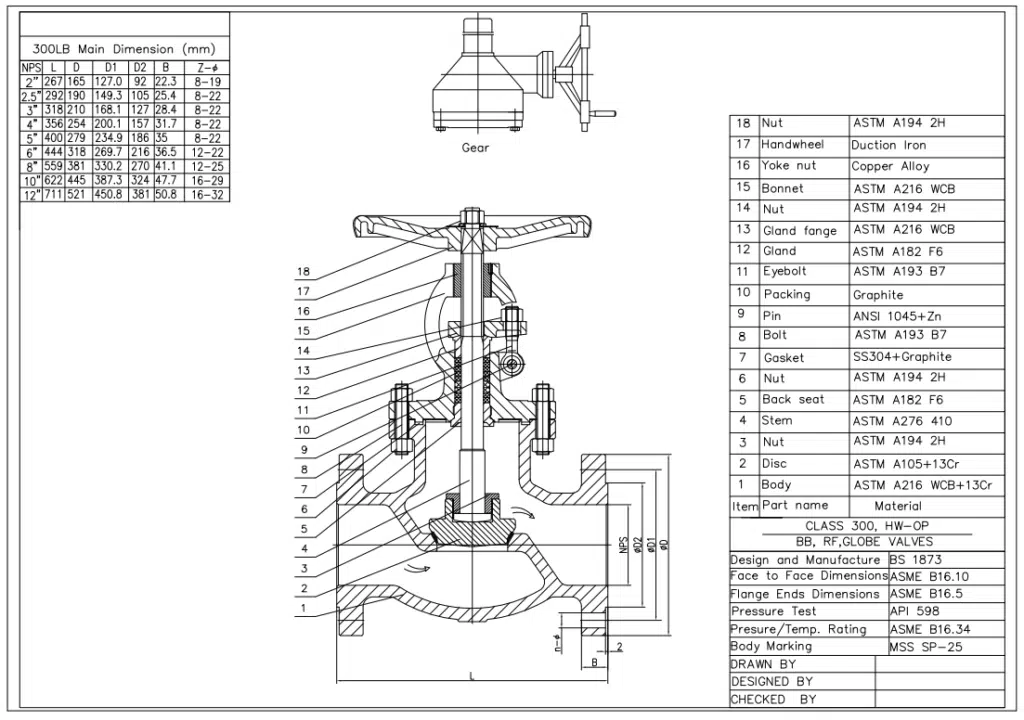
Types
Based on the different types of bodies of globe valves, there are three basic globe valves in the industry.
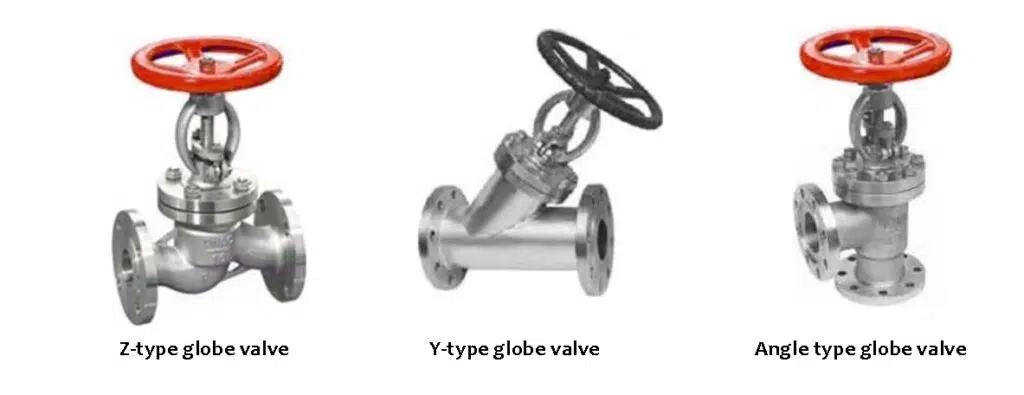
Z-type globe valve
This is the type of globe valve that most applications use. Horizontal seat adjustment allows the stem and valve plug to move perpendicular to the horizontal. The Z-type globe valve has the lowest flow coefficient and highest pressure drop.
Y-type globe valve
It is an alternative to a high-pressure drop with an angle of approximately 45 degrees. It provides a straight flow path when fully open, thus reducing resistance to flow. Y type globe valve has many advantages, such as long service life, easy installation, less friction during valve operation, easy maintenance, and lower cost. This type of valve is best suited for low and middle operating pressure conditions.
Angle type globe valve
The valve ends of angle type globe valve is 90° angle, which allows the fluid to through in a 90° turn.
Direction of Flow
General the direction of flow for the globe valve is from down to up which means the flow will go through from the downside of the plug and out by the upside.
Therefore, when the valve is closed, pressure must be applied to the valve disc to ensure that the seat is without leakage. When the medium enters the valve from below the plug, the resistance that the operating force needs to overcome is the friction of the stem and packing and the thrust that occurs by the pressure of the medium, thus the force to close the valve is greater than the force to open the valve. The diameter of the stem should be selected correctly because it needs enough strength to open the valve.
As we mentioned before, the normal direction of flow is from down to up, and the flow into from below plug, the advantage of this flow direction is that when the valve is closed the packing is not under pressure, which can extend the service life of the packing, and can be replaced in the case of pressure-bearing pipeline upstream of the valve. The disadvantage is that the valve driving torque is larger, and the stem is subject to axial force and easy to bend.
So we generally use flow down to up only applicable to below DN100 size globe valve, above DN200 globe valve usually uses flow up to down direction. Especially for electric/motorized globe valves used for power plants.
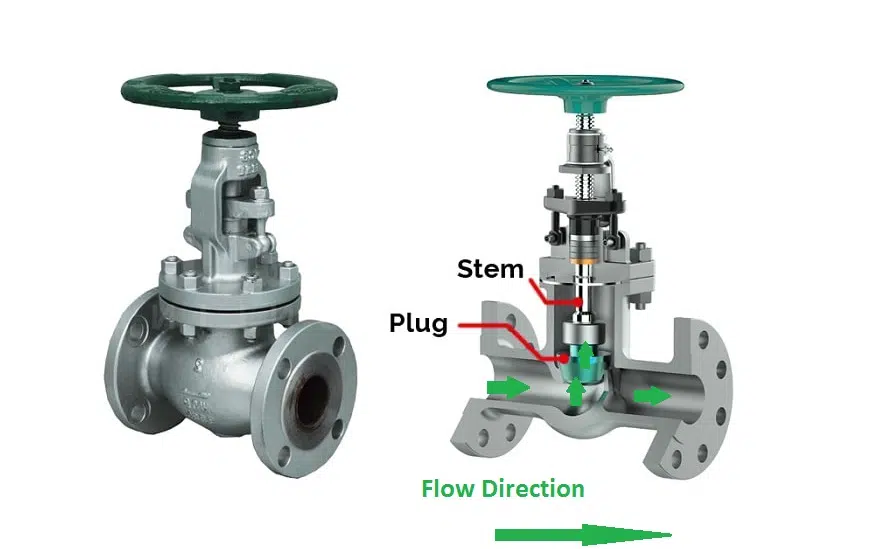
Function
Compare with the gate valve, the globe valve has higher pressure loss when the valve is fully open. The main function of the globe valve is to control flow capacity or downstream pressure or complete the on/off flow in the pipeline.
Cost of Globe Valve
Name: Globe Valve, OS&Y Bolted Bonnet, Handwheel Operator(Full Port)
Size:2″ to 12″
Pressure: ASME Class 150 & Class 300
Body Material: ASTM A216 WCB Cast/Carbon Steel
Trim Material: No.8/CR13/HF
Connection Type: Flanged Ends
| Size | Class | Description | Price |
|---|---|---|---|
| 2″ | 150 | 2″ 150RF Cast Steel Globe Valve | $144.50 |
| 2″ | 300 | 2″ 300RF Cast Steel Globe Valve | $207.5 |
| 3″ | 150 | 3″ 150RF Cast Steel Globe Valve | $225.5 |
| 3″ | 300 | 3″ 300RF Cast Steel Globe Valve | $280.5 |
| 4″ | 150 | 4″ 150RF Cast Steel Globe Valve | $327.00 |
| 4″ | 300 | 4″ 300RF Cast Steel Globe Valve | $420.00 |
| 5” | 150 | 5″ 150RF Cast Steel Globe Valve | $360.00 |
| 5” | 300 | 5″ 300RF Cast Steel Globe Valve | $480.00 |
| 6″ | 150 | 6″ 150RF Cast Steel Globe Valve | $517.00 |
| 6″ | 300 | 6″ 300RF Cast Steel Globe Valve | $792.50 |
| 8″ | 150 | 8″ 150RF Cast Steel Globe Valve | $912.50 |
| 8″ | 300 | 8″ 300RF Cast Steel Globe Valve | $1,203.50 |
| 10″ | 150 | 10″ 150RF Cast Steel Globe Valve | $1,699.50 |
| 10″ | 300 | 10″ 300RF Cast Steel Globe Valve | $2,679.00 |
| 12″ | 150 | 10″ 150RF Cast Steel Globe Valve | $2,390.50 |
| 12″ | 300 | 10″ 300RF Cast Steel Globe Valve | $3,137.00 |
For other sizes, materials, and other accessories, please just feel free to contact us: marketing(at)cncontrolvalve.com
What is Gate Valve?
A gate valve is the most common valve used in industrial pipelines. The gate valve is named because of the disc shape as a gate. It’s a linear motion type of industrial valve used for shutoff fluid flow. They can only serve for fully open or fully closed positions.

Design(Gate Valve Drawing)
Gate Valve 2”~16” Carbon Steel Class 150LB
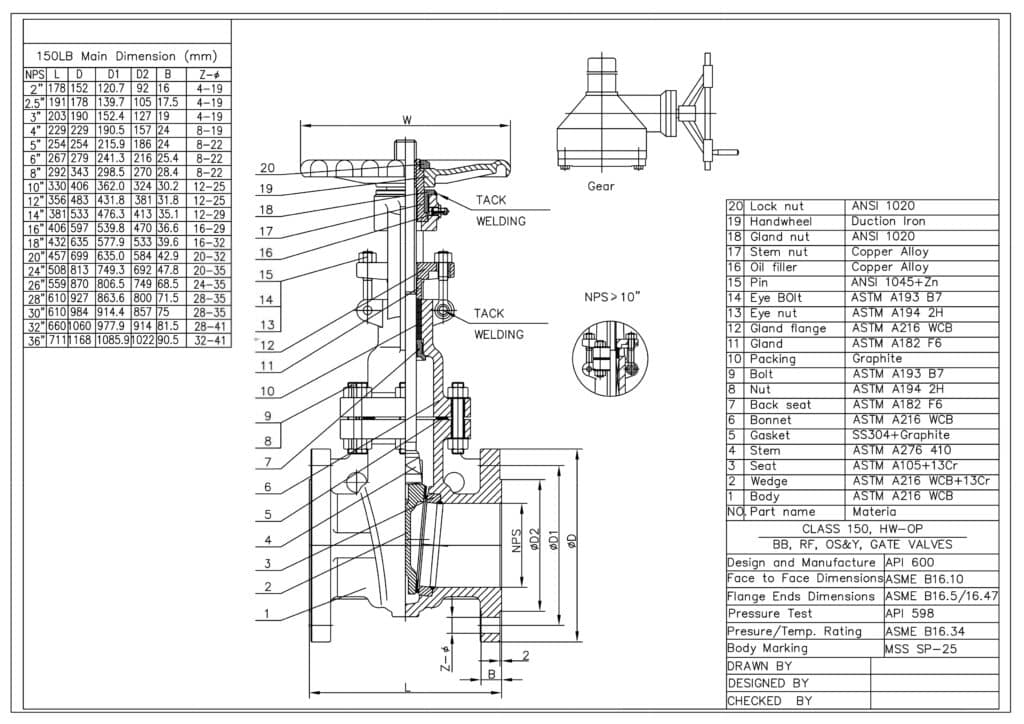
Gate Valve 2”~16” Carbon Steel Class 300LB

Types
The pressure drop in the gate valve is small because there are few obstacles in the passage to block the flow of the medium. The gate is operated by moving the gate disc up and down to open and close the valve. When the gate valve is closed, the disc moves down to meet the valve seat. Depending on the design of the valve disc, gate valves can be classified as the wedge, slab, knife, expanding, or parallel gate valves.
Direction of Flow
Gate valves can shut off fluid flow from either direction in the pipeline.
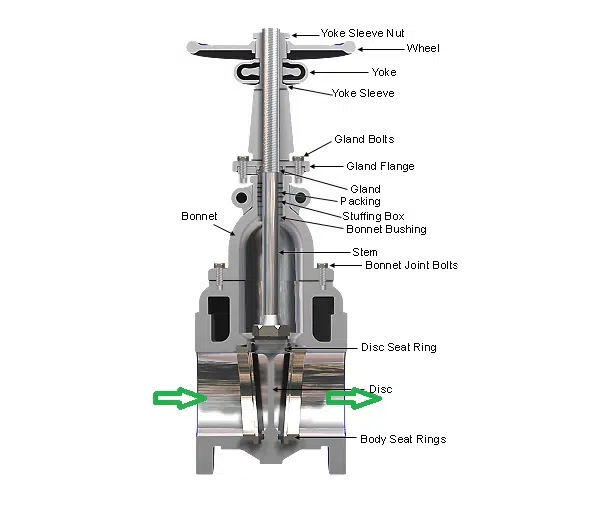
Function
The gate valve is used for the isolation of media flow. It is unlike the globe valve to used regulate the flow capacity or pressures but for complete shutoff of the flow.
A gate valve will not withstand the pressure of the flow of media in a partially open position, due to the disc is very thin, if the gate valve is partially opened, it will come from the vibration of the medium, which will cause this thin disc to be misaligned from its seat. This condition can cause damage and shorten its service life. So gate valve is only used for full open or full close function.
Cost of Gate Valve
Name: Gate Valve, OS&Y Bolted Bonnet, with Handwheel Operator(Full Port)
Size:2″ to 12″
Pressure: ASME Class 150 & Class 300
Body Material: ASTM A216 WCB Cast/Carbon Steel
Trim Material: No.8/CR13/HF
Connection Type: Flanged Ends
| Size | Class | Description | Price |
|---|---|---|---|
| 2″ | 150 | 2″ 150RF Cast Steel Gate Valve | $109.50 |
| 2″ | 300 | 2″ 300RF Cast Steel Gate Valve | $136.00 |
| 3″ | 150 | 3″ 150RF Cast Steel Gate Valve | $149.00 |
| 3″ | 300 | 3″ 300RF Cast Steel Gate Valve | $218.00 |
| 4″ | 150 | 4″ 150RF Cast Steel Gate Valve | $197.50 |
| 4″ | 300 | 4″ 300RF Cast Steel Gate Valve | $286.50 |
| 5” | 150 | 5″ 150RF Cast Steel Gate Valve | $220.00 |
| 5” | 300 | 5″ 300RF Cast Steel Gate Valve | $310.50 |
| 6″ | 150 | 6″ 150RF Cast Steel Gate Valve | $331.00 |
| 6″ | 300 | 6″ 300RF Cast Steel Gate Valve | $514.00 |
| 8″ | 150 | 8″ 150RF Cast Steel Gate Valve | $500.50 |
| 8″ | 300 | 8″ 300RF Cast Steel Gate Valve | $787.5 |
| 10″ | 150 | 10″ 150RF Cast Steel Gate Valve | $775.5 |
| 10″ | 300 | 10″ 300RF Cast Steel Gate Valve | $1,174.5 |
| 12″ | 150 | 10″ 150RF Cast Steel Gate Valve | $1,053.5 |
| 12″ | 300 | 10″ 300RF Cast Steel Gate Valve | $1,561.00 |
Globe Valve VS Gate Valve – Which Is Better?
You may see everywhere of the pipeline which installed globe valve and gate valve, these two types of industrial valves are the most general valve used in industrial pipelines. From the appearance of the valve, the globe valve and gate valve may look similar, in fact, they are completely different industrial valves not only for inner design but purpose.
1. Sealing surface
Gate valve in the process of opening and closing, the gate and seat sealing surface is always in contact and mutual friction, so the sealing surface is easy to wear, especially in the valve is approaching the closed state, the differential pressure is very large for gate, the sealing surface wear is more serious. The plug of the globe valve once in the open state, its seat and plug sealing surface are no longer in touch, so its sealing surface mechanical wear is smaller, but if the medium contains solid particles, it is easy to damage the sealing surface of the globe valve. Gate valve sealing surface has a certain self-sealing ability, its gate by the media pressure tightly in contact with the sealing surface of the valve seat, to achieve a tight seal and without leakage. The disc slope of a wedge gate valve is generally 3 to 6 degrees, when forced to close the excessive or temperature changes in the gate are easy to block. Therefore, high temperature, high-pressure wedge gate valves, in the structure are taken special measures to prevent the block. The sealing surface of the globe valve must be forced to close the valve to achieve sealing, in the same size, working pressure, and other conditions, the driving torque of the globe valve is 2.5 to 3.5 times that of the gate valve, so in the selection of the actuator for globe valve, you need to pay extra attention to the torque of the globe valve. The sealing surface of the globe valve is only in contact with each other when it is completely closed, and the relative slip between the plug and the sealing surface is very small, so the wear of the sealing surface is also very small. The wear of the sealing surface of the globe valve is mostly due to the debris between the spool and the sealing surface, or due to the tight closing state, caused by the high-speed scouring of the medium.
2. Structure
Gate valves are more complex than the globe valve structures, the height of the gate valve is higher than the globe valve, especially the bare stem gate valve requires a higher height space, which needs pay more attention to when we selections for limited in the installation space.
3. Flow resistance
Gate valve in the fully open the entire flow channel straight, at this time, the pressure loss of the operation of the medium is minimal, compared with the globe valve, its main advantage is that the fluid flow resistance is small, the flow resistance coefficient of an ordinary gate valve is about 0.08 to 0.12, while the resistance coefficient of ordinary globe valve is about 3.5 to 4.5. Gate valve opening and closing force are small, usually applicable to do not need to open and close frequently, and keep the gate fully open or fully closed working conditions, not suitable for regulating and throttling application. And globe valves in the entire travel of the flow resistance are very large, unbalance force also is large, the required driving force or torque is correspondingly much larger. But it is very suitable for use in fluid regulation, and throttling. For the high-speed flow of media, the gate in the partial opening condition may cause a vibration of the valve, which may damage the sealing surface of the gate and seat, and throttling, the gate will be subject to media erosion.
4. Valve travel
The travel of a gate valve is larger than that of a globe valve.
5. Valve direction of flow
When the globe valve is installed, the medium can enter from the bottom of the spool and from above in two ways. And the gate valve flows direction, from both sides into the same effect.
6. Maintenance process
Gate valve maintenance is not suitable for the on-site pipeline, while most of the globe valve seat and plug, can be replaced online, without the need to remove the entire valve from the pipeline.
Conclusion
In addition to the above 6 points, globe valves and gate valves also have many differences in application conditions. For example in small pipelines, globe valves are more popular when a required tight shutoff. In steam pipelines and large diameter water pipelines, gate valves are widely used because fluid resistance is generally required to be small. If you looking for a reliable valve manufacturer in Europe, you can find it in this article, or you can get the price list from THINKTANK also.





